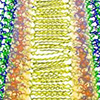| Dec 02, 2023 |
|
|
|
(Nanowerk News) Peptides, short chains of amino acids and vital components of proteins, are at the forefront of biotechnological innovation. These biological molecules are essential in numerous biological processes, such as oxygen and electron transport.
|
|
Emulating nature, researchers are pioneering the development of synthetic peptides that form into nanoscale fibers. These fibers are particularly intriguing because they conduct electricity when combined with heme, a natural substance crucial for electron movement in proteins.
|
|
The findings have been published in Nanoscale (“Designing 1D multiheme peptide amphiphile assemblies reminiscent of natural systems”).
|
|
The research delves into how the electrical conductivity of these peptide nanofibers is influenced by the amino acid sequence’s length and specific composition. Understanding these structural parameters is key, as they govern the function of peptides in nature and their potential in biotechnology. This includes the sequence length of the peptide segments and the arrangement of specific amino acids within a peptide.
|
 |
| Peptide molecules and heme disordered in solution (left) are transformed into an ordered one-dimensional (1D) self-assembled nanostructure (center) that supports electron flow, as imaged by Atomic Force Microscopy (right). (Image: Argonne National Laboratory)
|
|
The study’s findings are pivotal in designing peptide assemblies that can form nanoscale fibers capable of electron transport over long distances. Such advancements hold significant promise for applications in medical devices, biosensors, robotics, and the creation of new enzymes for industries ranging from healthcare to household cleaning.
|
|
In exploring the realms of materials science and biochemistry, researchers are particularly interested in protein and peptide nanostructures found in nature, known for their potential as bioelectronic materials. The creation of synthetic analogs, capable of forming one-dimensional nanostructures, is a significant stride in understanding natural systems and developing new materials.
|
|
At the Center for Nanoscale Materials at Argonne National Laboratory, a series of peptides, PA-(Kx)n or PA-Kxn, were investigated. These peptides self-assemble into one-dimensional layered nanostructures. Each peptide consists of modified alanine (c16-A), histidine (H), lysine (K), and a hydrophobic amino acid like leucine (L), isoleucine (I), or phenylalanine (F), with varying sequence repeat lengths.
|
|
The research team focused on how the peptide sequence length and the identity of the hydrophobic amino acid impact crucial factors like the binding affinity of heme to the pre-assembled peptides, heme density, and electronic properties. They discovered that a sequence length of two yielded the highest binding affinity, leading to nanoscale assemblies that organized heme into ordered arrays. These nanofibers, except for PA-KL1, exhibited a long aspect ratio, independent of the repeat unit length and sequence.
|
|
This discovery underscores the potential of such structures as supramolecular bioelectronic materials, which could revolutionize biomedical sensing and the development of enzymatic materials.
|


